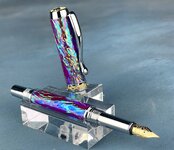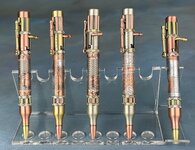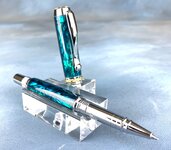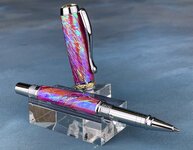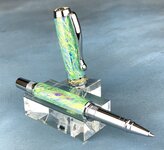Looking for some input from anyone with experience working with this product. I've tried many, many different methods and they all work fairly decently but sometimes Im just not wowed by it and I wonder if I could use some better methods or improvements.
I've tried micromesh before and I just could not get a great finish. Maybe I'm doing something wrong with it but I get a better finish with sandpaper and buffing. Currently I wet sand with abranet from 400-600. Sometimes I drop to 320 if I feel the need. I then use wet sand paper to 1,500. Then I would buff using the Beall system. I recently added the 'buffing kicked up a notch" wheels with even finer grit compound from Caswell and then my final step is blue rouge and a clean wheel. I didnt notice a huge difference adding those two wheels but it doesnt take much time and if it improves the finish at all Im good with it. I get a very good finish, but sometimes its not perfect no matter how I try. I have tried using plastic polishes, Meguiars (110 and then 210), Novus, Plastx, and all the others and I can't get that same level of shine and I see no improvement when I use them after the aforementioned process.
It seems so many people use micromesh I second guess myself that I am doing something wrong and should be able to get a great finish with it. So I guess Im just having one of those self doubt moments and questioning my process. So if anyone wants to share any tips or what they use specifically with alumilite I would love to hear it!
I've tried micromesh before and I just could not get a great finish. Maybe I'm doing something wrong with it but I get a better finish with sandpaper and buffing. Currently I wet sand with abranet from 400-600. Sometimes I drop to 320 if I feel the need. I then use wet sand paper to 1,500. Then I would buff using the Beall system. I recently added the 'buffing kicked up a notch" wheels with even finer grit compound from Caswell and then my final step is blue rouge and a clean wheel. I didnt notice a huge difference adding those two wheels but it doesnt take much time and if it improves the finish at all Im good with it. I get a very good finish, but sometimes its not perfect no matter how I try. I have tried using plastic polishes, Meguiars (110 and then 210), Novus, Plastx, and all the others and I can't get that same level of shine and I see no improvement when I use them after the aforementioned process.
It seems so many people use micromesh I second guess myself that I am doing something wrong and should be able to get a great finish with it. So I guess Im just having one of those self doubt moments and questioning my process. So if anyone wants to share any tips or what they use specifically with alumilite I would love to hear it!

